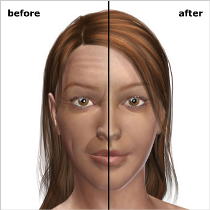If you’d like to restore youthful fullness to your face, enjoy plump lips, enhance shallow contours or soften those facial creases and wrinkles, dermal fillers may be the answer. Dermal fillers have been called “liquid facelifts” because they offer many of the benefits of a surgical facelift without the downtime.
Although they can’t help with excess sagging skin, these soft tissue fillers can add more volume and provide immediate results at a lower cost compared to surgery. But these treatment aren’t permanent; they must be repeated and maintained.
Some dermal fillers are used in conjunction with other skin rejuvenation treatments such as injections of botulinum toxin. Your plastic surgeon will assess your needs and recommend one or a combination of treatments to achieve your desired results.
 Wrinkle fillers can be divided into two categories: temporary and semi-permanent.
Wrinkle fillers can be divided into two categories: temporary and semi-permanent.
Temporary
Human fat, also known as autologous fat, is harvested from your own body. Using your own fat requires a more extensive procedure than other injectable fillers because you first must undergo liposuction to extract the fat prior to injection. By using your own fat, you eliminate the risk of allergic reaction or rejection by the body. You should know that not all of the live fat cells survive when transplanted into a new site. You can expect a fairly high rate of re-absorption. Because of this, your doctor will likely overfill the area being treated. At first you might look abnormal, but it will soon settle and you’ll enjoy a new look. When your doctor extracts this fat via liposuction, it’s possible that there will be more than is needed for one application. Most natural fat can be stored for touch-ups.
Collagen is a natural substance known as a protein, and the main component in cartilage, teeth and bones. It is derived either from human skin or cows (known as bovine collagen). Brand names include: CosmoDerm, Cosmoplast, Zyderm, Zyplast.
Human cadaveric dermis is skin that’s cultivated from a cadaver, then injected into your face. This substance results in particularly impressive filling of facial hollows. Brand names include: Cymetra, Dermalogen, Fascian.
Hyaluronic acid is also a natural substance found in your body. High concentrations are found in soft connective tissue and in the fluid surrounding your eyes. It’s also in some cartilage and joint fluids, as well as skin tissue. If the name sounds familiar, it’s because the same substance is often injected into the aching joints of people with arthritis to ease pain by providing extra cushioning. Hyaluronic acid is not derived from animal sources. Brand names include: Captique, Esthélis, Elevess, Hylaform, Juvéderm, Perlane, Prevelle, Puragen and Restylane.
Calcium hydroxylapatite, the heaviest of facial fillers, is found naturally in human bones. This mineral-like compound is reserved to fill the deepest creases such as nasolabial folds, marionette lines and frown lines. It’s also used to enhance fullness of the cheeks and other facial contours. Calcium-based microspheres are suspended in a water-based gel. Brand names include: Radiesse, Radiance.
Polylactic acid is a synthetic material. When it is injected, it stimulates the body’s own production of collagen. This substance is known to work particularly well in the lower half of your face, to fill the lines caused by laughing, to augment thin lips and fill out deep nasolabial folds. This substance is unlike other dermal fillers because it doesn’t produce immediate results. Instead, it stimulates collagen production, so results appear gradually over a period of a few months. Brand names include: Sculptra, New-Fill.
Semi-Permanent
PMMA (polymethylmethacrylate) fillers contain about 20 percent of tiny PMMA microspheres that are suspended in 80 percent purified collagen gel. This substance, considered semi-permanent, can be removed. PMMA is most often used to treat medium-to-deep wrinkles, folds and furrows, particularly nasolabial folds. It can also be used to fill out pitted scars and to augment thin lips. PMMA has been used for many years in permanent surgical implants. Because of this, your surgeon will likely under-fill on the first treatment, adding more later if needed. Brand names include: Articol, Artefill, Metacrill.
Assess.
First, your surgeon will listen to your desired results and then evaluate your facial appearance and skin tone, examining the areas of your face to be augmented with a cosmetic dermal filler.
Map a strategy.
Next, the surgeon will mark strategic points on your face as guides to the appropriate injection sites for the filler.
Clean the area.
Your injection sites will be cleansed with an antibacterial agent. Then a topical anesthetic will be used to numb the area, particularly if you are sensitive to injections. But in some cases, the dermal filler includes an anesthetic in the mixture.
Inject.
The actual injections will take just a few minutes total, and just seconds per site.
 Clean up and ice.
Clean up and ice.
The marks will be washed away and you will be offered an ice pack to reduce any minor and temporary discomfort. At this point you may apply makeup, but be careful not to apply pressure to the treated areas. Doing so may result in movement of the dermal filler.
A special note about scars and deep lines. These areas will often require multiple injections to achieve your desired results. If a deeper injection is required, you’ll be offered a local anesthetic to remain comfortable. Common sites for deeper tissue fillers are the nasolabial folds and marionette lines, or to enhance fullness in the cheeks.
There is no downtime with dermal fillers. You can resume most activities right away. Just take care not to rub the treated area so that the filler material remains undisturbed. You’ll likely experience swelling or a bit of bruising, which should fade within a few days.
If you opt for human fat as a filler, you’ll notice an “over-filled” appearance at first. It should resolve within a few hours or, in some cases, a few days. But for some people, this over-filled appearance could last for a few weeks.
Fillers that are derived from non-human sources require a pre-treatment allergy test.
Complications from fillers are uncommon. The risks include:
- Acne
- Antibodies, or rejection of filler material, may reduce the effectiveness of future injections.
- Asymmetry
- Bleeding
- Bruising
- Fillers that contain microscopic granular substances, particularly, calcium hydroxylapatite, may clump as a result of facial movement or your natural aging process. As time progress, these clumps can turn into lumps or nodules. Surgery can remove the lumps.
- Infection at the injection site
- Itching
- Migration of filler material away from the original site.
- Necrosis (skin death)
- Redness
- Skin rash
- Skin sensitivity
- Swelling
- Temporary numbness
- Temporary paralysis of facial muscles
- Under- or over-correction of wrinkles
In the long term
It’s important to realize that dermal fillers are not permanent. Even the semi-permanent variety require re-treatments eventually. The way your face continues to age and how your body absorbs fillers will determine the timing of repeat treatments.
If you decide not to re-treat, your appearance will return to its original condition. Wrinkles and scars will return, and plumped lips will lose volume.
Injectable dermal fillers can plump thin lips, enhance shallow contours, soften facial creases, remove wrinkles and improve the appearance of recessed scars.

Dermal fillers are wonderful to rejuvenate your appearance, but they can’t stop the aging process. If you want a permanent solution, talk to your doctor about a facelift, brow lift or eye lift.
Some people opt to have a liquid facelift, delaying the time when a surgical facelift is more appropriate. It’s a great way to see some impressive changes and improvements in your appearance, such as the reduction of forehead wrinkles, until you’re ready for a permanent surgical option.
Just remember, you’ll need to have repeat treatments with dermal fillers as a wrinkle treatment to maintain that fresh, full new look.
Cost is always a consideration in elective procedures or treatment. The cost for dermal filler treatments may vary based on the expertise and qualifications of the person performing the treatment, the type of procedure used, time and effort the procedure or treatment requires, as well as geographic office location. Many plastic surgeons offer patient financing plans, so be sure to ask. Additional fees may include:
- Surgical facility costs
- Anesthesia fees
- Prescriptions for medication
Be sure to ask your surgeon about all costs involved in your procedure.
Your satisfaction involves more than a fee
When choosing a plastic surgeon for a dermal filler treatment, remember that the surgeon’s experience and your comfort with him or her are just as important as the final cost of the procedure.
Most health insurance does not cover cosmetic surgery or its complications.
- Are you certified by the American Board of Plastic Surgery?
- Were you specifically trained in the field of plastic surgery?
- Is the office-based surgical facility accredited by a nationally- or state-recognized accrediting agency, or is it state-licensed or Medicare-certified?
- Am I a good candidate for a dermal filler?
- What will be expected of me to get the best results?
- Who will perform the dermal filler injections?
- Have they been specifiaclly trained in this procedure?
- Where and how will you perform my procedure or treatment?
- How long of a recovery period can I expect?
- What are the risks and possible complications associated with my procedure?
- How can I expect to look over time?
- Do you have before-and-after photos I can look at for this procedure?
- What results are reasonable for me?
To find a qualified plastic surgeon who performs this procedure, visit the online referral service of the American Society of Plastic Surgeons (ASPS). ASPS, founded in 1931, is the largest plastic surgery organization in the world and the foremost authority on cosmetic and reconstructive plastic surgery. All ASPS physician members are certified by the American Board of Plastic Surgery (ABPS) or the Royal College of Physicians and Surgeons of Canada.

Caution: In the wrong or inexperienced hands, delivery of dermal fillers can be dangerous. In addition to seeking a doctor who is trained and qualified in facial plastic surgery, make sure the physician has specific experience with these types of injections. Even though the injections may ultimately be delivered by another healthcare professional in the surgeon’s office, it will be with the surgeon’s close supervision.
 3510 N. Ridge Rd, Suite 100
3510 N. Ridge Rd, Suite 100